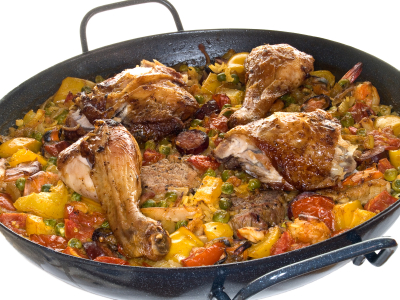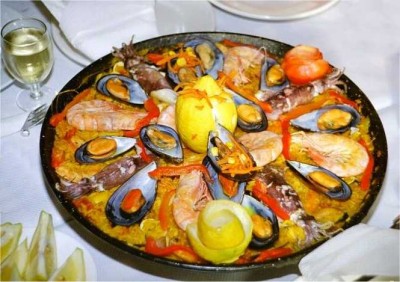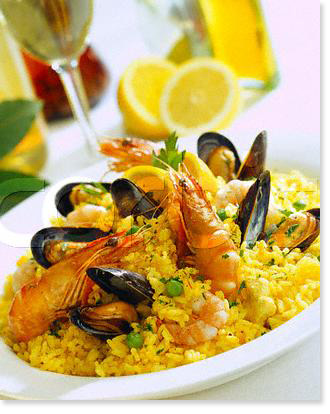
Origin: Valencia

Paella originated in Valencia. It's a humble dish with many years of tradition. It's popularity has been so large that there are many variations in different areas of Spain and known in the entire world. Most, if not all, Spanish restaurants in Spain and abroad serve paella.
The word paella means "frying pan" in Valencia which derived from the Latin patella. It receives its name from the large frying pan like implement used to cook it in, made of iron or steel, which must have no more than 5 or 6 cm of depth. The diameter depends on the number of diners. It can go from 10 cm to 90 cm. Another particularity is that the long handle has been replaced by two ears. So when the word paella is mentioned, it may mean the dish, it may mean the frying pan!
The history of paella takes us back to when rice was first imported in Europe, it may have been brought by the Romans, though some historians believe rice appeared in Spain before, imported by the Moors.
However things improved during the period when the Moors occupied the south of Spain, the irrigation systems brought by the Romans improved which in turn boosted the cultivation of rice. But that's not the only contribution the Moors made to the Spanish gastronomy, they brought with them saffron also, another of Paella's key ingredients.
When the Moors were expelled from Spain, rice was considered rather a vulgar cereal, as unprocessed it was very rough, and even though the Spanish had knowledge of growing it, it wasn't a popular crop.
However it is believed that it reappeared in kitchens during the 16th century, basically people prepared their food with whatever elements they had at hand, and we have reference of rice culture and the existence of paella in Valencia in the 16th century. In fact it was already a famous dish replicated in other regions of the country. However it hadn't gotten its name yet, and the dish was mentioned as Valencian rice. Paella would enter the Spanish language in Spain a couple of centuries later.
Spain's gastronomy developed according to the people's needs and availability of ingredients. It's hard to define the true "paella recipe" as the varieties are as assorted as the families that made them. Originally it was prepared with chicken and/ or rabbit and vegetables, but in the coast areas they added fish and shellfish to the mix, and other ingredients were added, such as sausages or chorizo.
Some purists will argue that there is only one way to make Valencian paella, but others say that it's true paella as long as it has the key ingredients. However there are some recognized variants, such as "paella marinera" (marine paella) which goes without most of the vegetable ingredients and replaces meat with fish, shellfish and other sea products and uses fish broth instead of pure water. Another example is "paella mixta" which mixes chicken and rabbit meat with seafood.This variant is popular in other regions of Spain but in Valencia it's hardly consumed.
From its beginnings paella has been a dish that gathers families and friends, or entire towns to celebrate events, and although it's mainly a dish for festivities, you will find the original and traditional paella in most restaurants in the region.

Ingredients (for four portions):
Preparation

It's traditional to let the paella stand for a few minutes, but it also serves a purpose. If the rice is still hard it will get more cooked, and if there's too much broth, it will soak in the rice
If you want to get very traditional, the paella is eaten straight out of the paella with wooden spoons!
Enjoy!